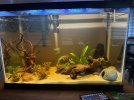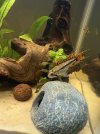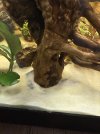apistonewbie
New Member
- Messages
- 26
Hey all,
I recently set up a 20 gal high breeding tank for my two apistogramma cacatouides and they had success with lots of little fry on their first attempt! While it is a joy to watch these fry, my male has seemed to be hiding more, often in the front left corner by the plant or the fake rock cave, and not as active. Is this normal behavior and will he be fine to stay in this tank for a while? He also seems to be consistently a bit round on the belly, my guess would be from my possible heavy hand while feeding them, but figured I would mention as it could be related. The spider-wood on the left also grows a fair amount of biofilm, which I clean every so often, but I doubt that would be a cause as from research I have seen it is beneficial. The fry will all be eventually sold to local stores, so I figured long term he would be ok, but worrying he may be getting quite stressed at the current stage. Any advice is appreciated!
I recently set up a 20 gal high breeding tank for my two apistogramma cacatouides and they had success with lots of little fry on their first attempt! While it is a joy to watch these fry, my male has seemed to be hiding more, often in the front left corner by the plant or the fake rock cave, and not as active. Is this normal behavior and will he be fine to stay in this tank for a while? He also seems to be consistently a bit round on the belly, my guess would be from my possible heavy hand while feeding them, but figured I would mention as it could be related. The spider-wood on the left also grows a fair amount of biofilm, which I clean every so often, but I doubt that would be a cause as from research I have seen it is beneficial. The fry will all be eventually sold to local stores, so I figured long term he would be ok, but worrying he may be getting quite stressed at the current stage. Any advice is appreciated!


